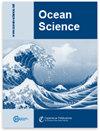利用资料同化模拟地中海正压海平面
IF 3.3
3区 地球科学
Q2 METEOROLOGY & ATMOSPHERIC SCIENCES
引用次数: 4
摘要
摘要本文分析了地中海海平面正压分量的变率及其在有无资料同化的水动力模式下的再现。在再分析和短期预报模拟中都考虑了数据同化的影响。我们使用了一个二维有限元模型和一个集合卡尔曼滤波器,该模型吸收了地中海盆地50个站点的每小时海平面数据。结果表明,即使在沿海地区和远离同化台站的地区(如地中海东南部),数据同化对天文潮汐、浪涌和正压总海平面的再分析也有显著改善。与再分析模拟一样,从分析状态开始的预测模拟有所改善,特别是在第一天(平均误差减少37%)和触发地震振荡时。由于流场是自由的正压振荡,只依赖于初始状态,因此数据同化可以非常有效地改善流场的再现。最后,我们通过谱分析的方法估计了这些振荡的周期和能量,在亚得里亚海,它们已经被广泛研究过,在地中海,目前的文献很少。在不进行同化的情况下,模型也能很好地再现周期,其能量也得到了很好的提高。本文章由计算机程序翻译,如有差异,请以英文原文为准。
Modelling the barotropic sea level in the Mediterranean Sea using data assimilation
Abstract. This paper analyses the variability of the sea level barotropic components in the Mediterranean Sea and their
reproduction using a hydrodynamic model with and without data assimilation.
The impact of data assimilation is considered both in reanalysis and short-forecast simulations.
We used a two-dimensional finite element model paired with an ensemble Kalman
filter, which assimilated hourly sea level data from 50 stations in the Mediterranean basin. The
results brought about a significant improvement given by data assimilation in the reanalysis of
the astronomical tide, the surge, and the barotropic total sea level, even in coastal areas
and far from the assimilated stations (e.g. the southeastern Mediterranean Sea).
As with the reanalysis simulations, the forecast simulations, which start from analysis states,
improve, especially on the first day (37 % average error reduction) and when
seiche oscillations are triggered.
Since seiches are free barotropic oscillations that depend only on the initial state, their
reproduction improves very effectively with data assimilation. Finally, we estimate the
periods and the energy of these oscillations by means of spectral analysis, both in the Adriatic Sea,
where they have been extensively studied, and in the Mediterranean Sea, where the present
documentation is scarce. While the periods are well reproduced by the model even without
data assimilation, their energy shows a good improvement when using it.
求助全文
通过发布文献求助,成功后即可免费获取论文全文。
去求助
来源期刊

Ocean Science
地学-海洋学
CiteScore
5.90
自引率
6.20%
发文量
78
审稿时长
6-12 weeks
期刊介绍:
Ocean Science (OS) is a not-for-profit international open-access scientific journal dedicated to the publication and discussion of research articles, short communications, and review papers on all aspects of ocean science: experimental, theoretical, and laboratory. The primary objective is to publish a very high-quality scientific journal with free Internet-based access for researchers and other interested people throughout the world.
Electronic submission of articles is used to keep publication costs to a minimum. The costs will be covered by a moderate per-page charge paid by the authors. The peer-review process also makes use of the Internet. It includes an 8-week online discussion period with the original submitted manuscript and all comments. If accepted, the final revised paper will be published online.
Ocean Science covers the following fields: ocean physics (i.e. ocean structure, circulation, tides, and internal waves); ocean chemistry; biological oceanography; air–sea interactions; ocean models – physical, chemical, biological, and biochemical; coastal and shelf edge processes; paleooceanography.
 求助内容:
求助内容: 应助结果提醒方式:
应助结果提醒方式:


